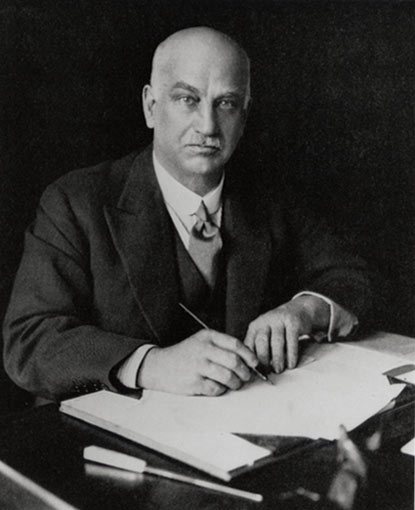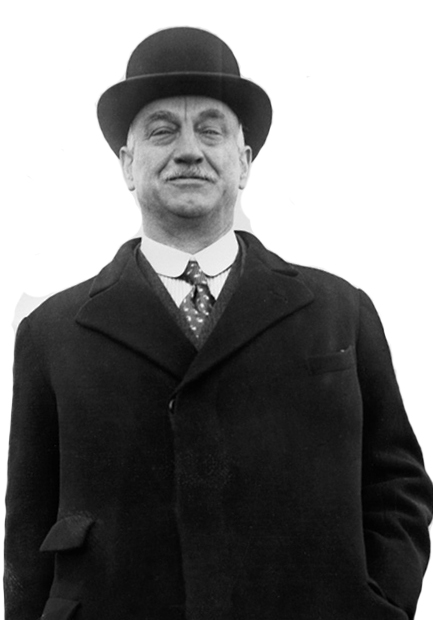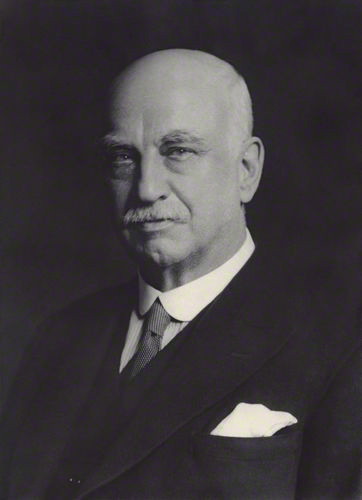<Back to Index>
- Automobile Designer Herbert "Pa" Austin, 1st Baron Austin, 1866
- Writer Sarah Fielding, 1710
- Prime Minister of France Jean Raphaël Adrien René Viviani, 1863
PAGE SPONSOR



Herbert 'Pa' Austin, 1st Baron Austin KBE (8 November 1866 – 23 May 1941) was an English automobile designer and builder who founded the Austin Motor Company.
The son of a farmer, he was born in Little Missenden, Buckinghamshire, in South East England, but the family moved to Wentworth Woodhouse, near Rotherham, Yorkshire, in 1870 when his father was appointed farm bailiff. Herbert Austin first went to the village school, later continuing his education at Rotherham Grammar School.
In 1884 he emigrated to Australia, with an uncle, on his mother's side, who lived in Melbourne, Australia, but had recently returned to England on a family visit. They travelled to Australia by ship, via the Cape.
He initially started work with his uncle who was the works manager at a general engineering firm, Mephan Ferguson, in North Melbourne. However, after two years, he left to join a company called Cowen, which was an agent for printing equipment and Crossley engines. He later worked for the Longlands Foundry Company in Melbourne which made locomotive boilers, wheels and gold mining equipment.
Herbert Austin attended Hotham Art School in Melbourne to develop his skills in drawing. During this time, he submitted a design for a swing bridge over the Yarra River at Spencer Street, Melbourne, but did not win the competition organised by the Government of Victoria.
He met and married his wife, Helen Dron, in Melbourne. She was born in Melbourne, the seventh daughter of Scottish parents. Herbert and Helen were married on 26 December 1887 and bought a house in Melbourne. They had a son, Vernon James, who was killed on 26 January 1915, serving in World War I, and two daughters, Irene (born in 1891) and Zoe (later to become Mrs Lambert).
Three days before his marriage, Austin left the Longlands Foundry Company to work as manager of an engineering workshop owned by Richard Pickup Parks, who had developed a new sheep - shearing machine for Frederick York Wolseley.
After
spending three months improving the sheep - shearing machine, Herbert
Austin was asked to join the Wolseley Sheep Shearing Machine Company,
founded in 1887 in Sydney. Shortly after joining, he was sent to a sheep station at Avoca to study the machines in use. Austin had patented in
his own name the improvements he had made to the sheep - shearing
machines, but sold the patents to the Wolseley Sheep Shearing Machine
Company on 10 March 1893 in exchange for shares.
He returned to England by ship with Frederick Wolseley, docking at Tilbury in November 1893.
Wolseley had closed down the Sydney - based company and transferred it to a company registered in London. Wolseley set up a factory in Broad Street, Birmingham, where Austin became manager. Fredrick Wolseley resigned from the company in 1894. The Broad Street factory was not large enough so Austin bought a bigger one in Aston, Birmingham. During slack periods in the year they built bicycles.
Becoming interested in motor cars, Austin built two different types in his own time. A version of one of these was taken up by the Wolseley Sheep Shearing Machine Company and listed for sale in 1900. In 1901 Vickers bought out the car interests of Wolseley to form the Wolseley Tool & Motor Company and Austin moved to the new company, in Adderley Park, Birmingham, but was allowed to continue working part time for the Wolseley Sheep Shearing Machine Company. He was chairman of the board of the Wolseley Sheep Shearing Machine Company from 1911 to 1933.
In 1905 Austin resigned from the Wolseley Tool & Motor Company, taking some of the senior staff with him. His brother Harry also joined him in this new venture, having worked with him at Wolseley in Birmingham. Austin raised capital of £37,000 and embarked on a search for a factory that could accommodate his idea for a new car manufacturer. He took over an old print works, still outside Birmingham, in Longbridge, which was then in the County of Worcestershire; Longbridge did not become a suburb of Birmingham until 1911 when the city's boundaries were expanded. The Austin car works at Longbridge was later to become one of the greatest car manufacturers in the world.
Austin was producing 17 different models by 1908. During the First World War Austin produced munitions and built Austin Village in Turves Green for his workers. The car business was difficult after World War I; the Austin company was threatened with bankruptcy in 1921 and a receiver was appointed. The "Baby Austin" was
launched in 1922 and offered for sale at £225, putting it within
the budget of customers who had never previously owned a car. Its output
reached 25,000 annually by 1925; the price was reduced each year. In
1931, the Austin 12/6 was introduced, followed by the Austin 12/4 in 1933.
The company turned its resources to the war effort in 1914 and, in 1917, Austin was knighted for his services and also received the Belgium Order of the Crown of Leopold II, for the employment of 3,000 Belgian refugees at Longbridge.
During World War II, the company specialised in making aircraft; Horsa glider fuselages; specialist army vehicles; hydraulic motors for gun turrets; ammunition boxes, magazines for machine guns, tommy guns, Oerlikon anti - aircraft guns; marine engines for ships lifeboats; and pressings for jerrycans.
Up until 1938, the Air Ministry had been headed by Lord Swinton, who at that point had been forced to resign his position by Prime Minister Neville Chamberlain due to a lack of progress in re-arming the Royal Air Force. New minister Sir Kingsley Wood implemented a new plan to treble British aircraft production in the run up to WW2 in two parts:
- Development of nine new factories;
- Extension and extensions to existing factory complexes to allow either easier switching to aircraft industry capability, or production capacity expansion.
Underneath
the plan, there was government funding for the building of these new
production facilities, in the form of grants and loans. Key to the plan
were the products and plans of Rolls - Royce Limited, whose Merlin engine powered
many of the key aircraft being developed by the Air Ministry. Austin
was placed in charge of implementing the scheme on the producers side,
who were mainly motor vehicle manufacturers; while technical liaison
with the aircraft industry was placed with Charles Bruce - Gardner.
From 1918 to 1924, Austin served as Conservative Member of Parliament (MP) for Birmingham King's Norton but never made a speech in the House of Commons. In 1936 he was created Baron Austin, of Longbridge in the City of Birmingham. In 1937 he received a Doctor of Laws (LL.D.) from the University of Birmingham.
Lord Austin died from a heart attack and a bout of pneumonia. The peerage became extinct on his death.